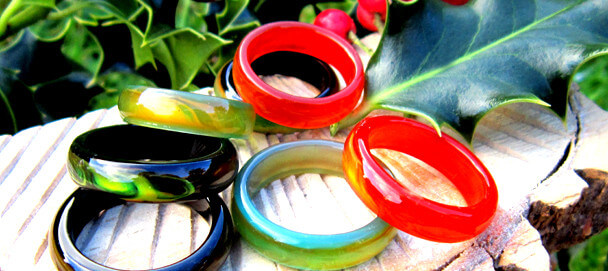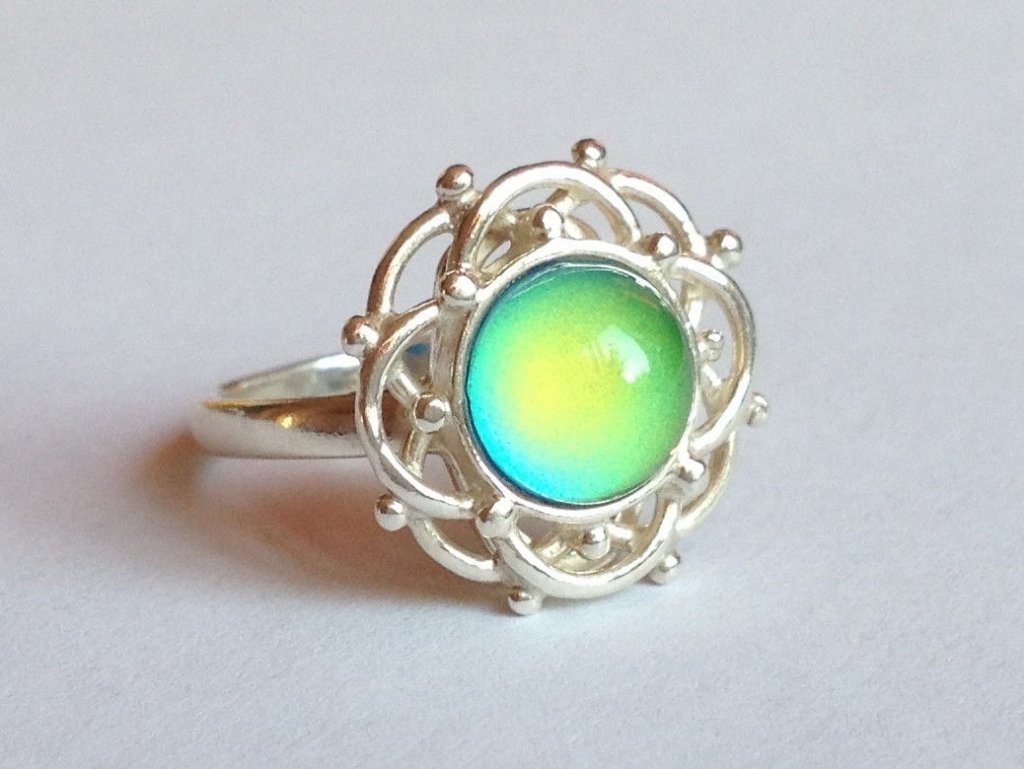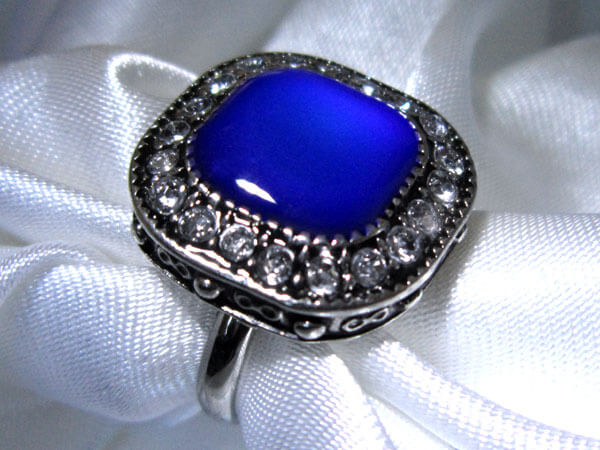It is the basic question which will arise in any person’s mind that has little information about mood rings like what are Mood Ring Colors, what are their meaning, how does mood ring work. Mood rings are basically a unique ring which contains liquid crystal that changes the color according to our body temperatures. The mood ring was created in 1975 by two New York inventors, Josh Reynolds and Maris Ambats, who bonded liquid crystals with quartz stones set into rings. The crystals respond to changes in temperature by twisting. The twisting changes their molecular structure, which alters the wavelengths of light that are absorbed or reflected resulting in the changes of replacement in the mood ring colors. For example, if you are under stress your body direct blood toward your internal organs, with less blood reaching your fingers.

Table of Contents
Mood ring colors and their meanings??
The mood ring changes color so as well as there is different shapes of rings which also shows a wonderful range of colors.
For example – the oval ring that shows a wonderful range of colors.
So there are some more examples which state the changing of a person’s mood. There are few points mentioned below about different colors of the rings along the reasons of the change in the colors.
- As the ring starts off at a cold temperature showing a black or dark color. According to the Mood Color Guide this means the person is showing a darker mood such as fear or they feel stressed.
- They also heats up it turn yellow. Then the ring turns to oranges and greens. Again this shows that the wearer is nervous or unsettled.
- There is a color in between green and blue, which states that you are Upbeat, Pleased, Somewhat Relaxed, Motivated and Flirtatious. The color is named as blue–green. Which is a mixture of emotions you are feeling or the temperature of your body is varying from one point to another.
- As soon as the temperature turns down into normal the ring color changes into blue. Which proves that it is more common color that states the temperature is back to normal range.
- The final change is that the color grows darker. The darker the emotion shows that you are in a very romantic mood. The color changes from purple, red and pink stages where the temperature is much hotter. The range of emotions here varies from happy to romantic.
All these changes in colors are very beautiful and unique. The corresponding change occurs according to the wearer’s mood. A Mood Color Chart will show all the colors the ring will turn and the emotions the person is showing.
A general guideline is been provided to show what each color on a mood ring tells about your emotional state.
Black:
This color is the default color of the mood ring if the ring is not worn out. The black color shows some indication of some negativity. It signifies that the wearer is tensed, angst, overworked, harassed or tied.
White:
The color itself speaks the mood of the person. Whether he/she is confused, frustrated or feels bit of boredom.
-
Gray:
This is the most frequent color observed in the mood ring. When this color gets into the ring, it indicates that the wearer is sad, afraid, exhausted or anxious.
-
Shades of Green:
When the shades of pleasing green appear on the mood ring, it indicates the person is active but relaxed. It is considered as the normal reading as your mood ring is likely to reflect the shades of green. When your mood ring shows a bluish tint to green, it means the wearer is somewhat relaxed, but his/her inner emotion is stirred up. Different shades of green meanings are illustrated below:
- Simple Green: when this color appears it indicate that the person is calm, peaceful, and normal reading.
- Dark Green: it states that the person is occupied with something but aware of the surroundings.
- Bright Green: Shows how energetic and wandering you are in nature.
- Amber: This color provides the mixed emotions and wandering.
- Blue Green: The person is shown relaxed but his/her inner emotions are all stirred up.

-
Shades of Blue:
Blue is the color of joy and optimism. When the wearer is relaxed, happy or at peace, the gemstone on the mood ring would most likely turn into blue. Generally, the pleasing colors indicate a pleasant vibe. There are different colors of Blue and their meanings:
- Pleasing Blue: Keeps you happy, relaxed and calm.
- Dark Blue: This color shows the most intensified mood, love, and extreme joy, passionate or feeling romantic.
- Cobalt Blue: The person feels happy and talking from the heart.
- Deep Teal: Helps you in deep thinking and makes you feel motivated.
- Aquamarine Blue: It makes you feel flirty and upbeat.

-
Purple Shades:
When the mood ring shows purple color, it means the person is sensual but has a mental clarity.
- Indigo: The color indicates tranquility feeling, inner balance and satisfied.
- Deep Purple: This color shows how sensual, romantic and passionate mood you are in.
- Reddish Purple: The ring color shows that the person is in desperate, moody and angry
- Pink: Shows Calm and relaxed mood.
- Bright Pink: Makes you feel happy, lovable, and affectionate.
-
Shades of Red:
Red is associated with an emotional state of passion. It remains the same even in the world of mood rings too. Signifies energy, excitement and adventure. It indicates the person is in a romantic mood.
- Deep Red: It shows the person is in the mood of lovable, aroused, and passionate.
- Bright Red: Makes you feel excited, anger, terrified, and feeling adventurous
- Orange Red: This color shows that you are dare devilish, stressed, confused.
- Dark Orange: The color indicates that you are worried, tensed, aggressive, aggravated.
-
Shades of Yellow:
If the color on a mood ring is yellow, it indicates the wearer is imaginative and his thoughts are wandering.
- Simple Yellow: Shows how imaginative you are.
- Yellow Orange: This color shows how upset, anxious, and confused you are.
- Bright Yellow: The color indicates that you are observing deeply, feeling poetic.
-
Shades of Brown:
- Simple Brown: Proves how restless, scared and tense mood you are in.
- Brownish Yellow: Feel with various mixed emotions.
- Taupe: Shows how aggravated, angst, stressed, confused of yours.
When the gemstone changes with the shades of violet from red to blue or vice versa, it indicates that the wearer is in a sensual mood.
How do mood ring work?
The science behind mood rings is quite simple. You just have to wear it on your finger and then it would reflect the state of your emotions. There are different colors shown as a indication to different moods a person is feeling. Like the ring will turn dark blue when a person is feeling happy and it would turn black if he or she is anxious or stressed. There is no exact accurate science behind it but it is just the way to show how your body involuntary physical reaction changes according to your emotional state.
There are two ways to create a mood ring. First one is you can use hollow glass shell filled with the thermo tropic liquid crystal and other one is to use a clear glass stone sitting on the top of the thin sheet of liquid crystal. The molecules of these liquid crystals are quite sensitive to temperature. As the temperature changes they changes their position and structure and then it affects the wavelength of light being absorbed or reflected by the crystal. resulting in the apparent change in color.
Who Invented mood ring?
It was invented in late 1970’s by the two New York scientists, Josh Reynolds and Maris Ambats It was first sold at Bonwit Teller. They priced $ 45 for its silver setting and $250 for its gold setting.




























